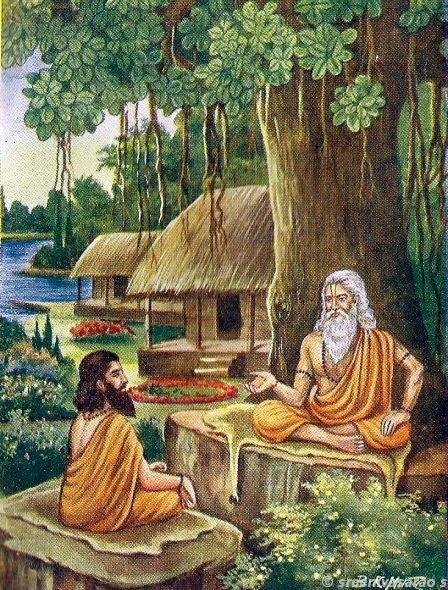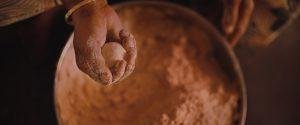Ayurveda and Kerala Ayurveda – A Quick Look at the History and Origin
India’s gift to humanity is a treasury of knowledge collectively called ‘The Vedas’ dating back to approximately 8000 BC. Within the verses of the Vedas lies the mysterious history and origins of Ayurveda as we know it now.
Sages and Sadhus give their lives for study and research.
When we think of Vedas, think of a library of encyclopedias, a treasure trove of knowledge of about 219 volumes, each one focusing on a specific aspect of living successfully. What exists today is only 1% of what used to be studied and preserved during the Vedic times.
“ the original Vedas were comprised of 1,180 sakhas (i.e. branches), of which only 7 or 8 sakhas (less than 1 %) are remembered now. As a result, it is only natural to expect that even within the texts that were finally documented, various errors and omissions had crept in.”
The Vedic period, the time when the Vedas were written down, is said to extend through the later Bronze and Iron Ages in the North of India, possibly around 3300 BCE.
You will notice dates being off, as historians do not agree based on estimated antiquity of various artifacts found, mentions in surviving literature and mentions of events that happened at a similar time that have a clear date, for example, the drying up of a river, a historic flood, the birth of Buddha, etc.
The Vedas were inscribed on dried palm leaves. Each manuscript had a life of about 600 years and lineages, who were guardians of that particular Veda, rewrote the manuscript as the old ones wore out.

The Bower manuscript named after Hamilton Bower, a British Lieutenant, is the oldest surviving palm leaf on Ayurveda from the 5th or 6th Century AD.
Before the the Vedas were written down, they were passed down orally and were known as “Shruti” or heard knowledge and prior to that, they were “Smriti “ or remembered knowledge. Entire communities lived on patronage from wealthy clans, their sole purpose was to recall and recite entire books. This was a sacred duty and God and good karma was tied to this work.
The Vedas are classified into four major Vedas, each holding several sub-Vedas.
Ayurveda
Ayurveda is a sub-Veda of Atharva Veda, the fourth and last Veda which outlines and describes all practical matters concerning a long successful prosperous life as a human.
(Ayurveda is also mentioned in the Rig Veda.)
The verses that make up the Ayurvedic texts were compiled as poetry and prose by ancient research scientists who minutely observed nature, the environment, living beings, natural behaviors of plants and animals, experimented with their hypothesis, and came to evidence-based conclusions.
This knowledge filtered down through the centuries and a large collective of physicians tested the instructions, the medicinal properties, and symptoms of diseases. What was found to be accurate and reliable was passed on to the next generation of students. Only the most respected dared to make changes due to the sacred nature of this knowledge.
Ayurveda is the guiding knowledge by which a healthy human can live all aspects of life here-physical, mental, intellectual, and spiritual, based on dharma, righteous action.
The classic texts focus mainly on living a long healthy life, the prevention of diseases, and the onset of senility. A comparatively smaller portion of this knowledge is dedicated to the curing of diseases.
Prevention is greatly emphasized by dinacharya or wholesome daily rituals, food combinations and dos and don’ts related to diet, environment, behavior towards others, and the influence of thoughts and poor habits.
All learned physicians stress the importance of dinacharya and ritucharya (seasonal rituals), disease management is the last resort.
Ayurveda Acharyas
The three original Ayurveda acharyas, respectfully called Brihat Trayees, or the three most highly respected teachers were Sushruta, Charaka, and Vagbhata.
Madhavanidana, Sarngadhara Samhita, and Bhavaprakasa are the popular Laghu Trayees or the lesser trio written by comparatively lesser-known physicians Acharya Madhava, Pandit Sarngadhara and Bhava Mishra respectively. These books are also still in use by modern Ayurveda physicians.
Ayurveda materia medica Charaka Samhita (Charaka’s compilation) and Sushruta Samhita (Sushruta’s compilation) were written down in 600 BC and 1000 BC respectively.
These two physician sages were possibly Hindu or Buddhist or the times were such that what was prevalent was an amalgam of Hindu-Buddhism.
Sushruta was the physician to the King of modern-day Varanasi or ancient Kashi and his remedies focused on surgical methods and tools, which he possibly gained his mastery over by healing wounded soldiers.
He scientifically depicted the various aspects of human biology, anatomy, surgery, and surgical instruments in his ‘Sushruta Samhita’.
This great classic on the science of surgery earned him the title of ‘father of surgery’.
Vagbhata’s contribution to Ayurveda was redacting his grandfather’s voluminous medical text called Ashtanga Sangraha into a much more lucid volume called Ashtanga Hridaya, the heart of the Ashtanga knowledge, the eight branches of Ayurveda medicine.
Vagbhata was from the Indus Valley Civilization, which was called Sindhu Desha, the land of the people of the Sindhu River.
(The Sindhu river drains out of Mansarovar Lake in the Tibetan plateau, on the northern slopes of the Kailash Mountain Range and runs through Pakistan.)
The texts mentioned by the greater trio, Charaka Samhita and Sushruta Samhita are called Akara granthas. This means they are authentic original works of the authors.
Ashtanga Hridaya is called as Prakarana grantha i. e., a manual created by references from other texts in use during the time.
Out of all eight branches of Ayurveda, Acharya Charaka has given his highest priority to Kayachikitsa i.e. general medicine, whereas Acharya Sushruta emphasized surgical interventions in his text Sushruta Samhita.
Acharya Vagbhata has given equal importance to all the eight branches in Ashtanga Hrdaya. It consists of 6 divisions and 120 chapters.
He called it the complete manual for the physician of the future who may not possess the intelligence of the giants of the past.
Various authors have written many commentaries on Ashtanga Hridaya Samhita, Arunadutta’s ‘Sarvangasundari‘, and Hemadri’s ‘Ayurveda Rasayana‘ are popular commentaries in use today.
Kerala Ayurveda
The special therapeutic system of Kerala Ayurveda came about after Vagbhata, or one of his followers, traveled from the Sindhu river region of the Indus Valley to the nearly inaccessible South of India, Kerala, possibly with a merchant ship.
Kerala’s Muziris was a well-known trading harbor where merchants from China, Greece, and Rome arrived for spices, oils, textiles, and ivory.
Vagbhata brought with him his Sanskrit medical text “Ashtanga Hridaya” which he had distilled from the various practices prevalent in North India.
Vagbhata or his disciples were warmly received in Kerala and established schools of learning called Sabhaamadhams in Pulamanthole village.
Originally eighteen families took formal discipleship and studied Sanskrit. These traditionally trained hereditary practitioners were folk healers, poison experts, herbalists, and performed priestly rituals for well-being.
These families came to be known as the Ashtanga Vaidya families, shortened to Ashta Vaidya families. As time passed they took their craft to Thrissur, to Calicut and beyond, to Vellode and Cherthala, all regions in Kerala.
While colonialism wiped out the knowledge of Ashtanga Hridaya from most of North India, the Ashta Vaidya families in Kerala preserved the original practices especially that of Panchakarma cleansing.
(The original Ashta Vaidya families have a suffix of Mooss or Nambi in their names to identify them as the original families.)
The Ashta Vaidyas offered Ayurveda physician training to all classes through apprenticeship schools of their own and the knowledge spread far and wide in Kerala.
Some eminent Ashtavaidya physicians are Ashtavaidyan E.T. Neelakandan Mooss, Padmabhushan Ashtavaidyan Sri. E.T. Narayanan Mooss, Ashtavaidyan P.T.N. Vasudevan Mooss
“After studying for 20 hours for 20 years I have learned a little of Ayurveda.”
– Padmashree Ashtavaidya PR Krishna Kumar, Managing Director of Arya Vaidya Pharmacy Coimbatore
Several of these Ayurveda Vaidya family lines, like mine, have died out due to lack of willing heirs.
Some of my Vaidya ancestors are – Kunjan Panicker Vaidyan a physician to the Travancore Royal House with his own academy, my great grandfather: Kurumba Amma Vaidya, my great grandmother, his wife: Kunjamma Vaidyar my grandmother: Palmanabhan Shanti, my grandfather who was also a priest, as many Ayurveda physicians are: Pappiamma Vaidyar, my maternal great grandmother; Raghavan Vaidya, my maternal grandmother’s brother.
This makes me a passionate advocate for the preservation of this indigenous healing art through wellness travel.
Science and God

All Hindu sciences and arts have a presiding God who blesses students with knowledge and success in achieving mastery over the art.
Dhanvantari, an aspect of Vishnu, the God of preservation, is the patron Hindu god of Ayurveda medicine. Vaidya lineages have a temple dedicated to Dhanavantari in their family compound.
Many interpret this association literally, which is clearly not true.
Ayurveda is a living breathing work of exemplary sage scientists who left little to no trace of their personal history.
Today Vagbhata’s Ashtanga Hridaya is considered the main reference for Ayurveda students and is taught in Ayurveda medical colleges.
To note, the Ashta Vaidya Ayurveda of Kerala which offers personalized ancestral methods of treatment and the standardized version of Ayurveda compliant with bio-medicine that is practiced by Ayurveda doctors elsewhere is vastly different.
Many physicians I refer clients to are from traditional Kerala Ayurveda lineages and are trained as MDs in Ayurveda in accordance with licensing laws that require practitioners to have undergone formal training.
Even though the great visionaries of Ayurveda have passed away, and their history has gone with them, this art and science of healing are thriving more than ever.
Ayurveda physicians from all over India and the world continue to be guided by the timeless fundamentals of equilibrium and homeostasis. To an intelligent physician, this is adequate to close the gap and offer effective complementary care.
Who is your favorite Ayurveda physician and what have you learned from her?
Don’t hesitate to reach out and say hello on Instagram
*Historical Data courtesy of scholarly articles of Mrinal Kanti Das, Soumitra Kumar, Pradip Kumar Deb, Sundeep Mishra, Dr. Valiathan and Dr. Indhudhara Menon.





Awesome! Its genuinely remarkable post, I have got much clear idea regarding from this post